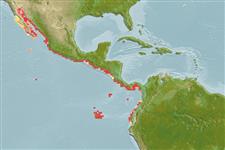Environment: milieu / climate zone / depth range / distribution range
Écologie
marin; profondeur 0 - 50 m (Ref. 189). Tropical; 33°N - 3°S, 116°W - 77°W (Ref. 189)
Eastern Central Pacific: southwestern coast of Baja California, Mexico and the Gulf of California to Panama and the Galápagos Islands.
Taille / Poids / Âge
Maturity: Lm ? range ? - ? cm
Max length : 17.0 cm TL mâle / non sexé; (Ref. 114986); common length : 9.5 cm SL mâle / non sexé; (Ref. 9298)
Description synthétique
Clés d'identification | Morphologie | Morphométrie
Épines dorsales (Total) : 0; Épines anales: 0; Rayons mous anaux: 15 - 19. Body rather elongate, but somewhat compressed. Snout moderate, about 3/4 eye diameter; maxilla moderate, tip narrowly pointed, reaching onto sub-operculum, but not to edge of gill cover; gill cover canals of panamensis-type. Anal fin short, its origin below posterior third of dorsal fin base. A narrow silver stripe along flank, deeper above anal fin (about 3/4 to 2/3 eye diameter).
A schooling species occurring in coastal waters. Pelagic. Frequently caught over sand or gravel in the Gulf of Nicoya, Costa Rica, but also over mud.
Life cycle and mating behavior
Maturities | Reproduction | Spawnings | Egg(s) | Fecundities | Larves
May spawn throughout the year in the Gulf of Nicoya, Costa Rica (Ref. 189). Spawn in school (Ref. 205).
Whitehead, P.J.P., G.J. Nelson and T. Wongratana, 1988. FAO Species Catalogue. Vol. 7. Clupeoid fishes of the world (Suborder Clupeoidei). An annotated and illustrated catalogue of the herrings, sardines, pilchards, sprats, shads, anchovies and wolf-herrings. FAO Fish. Synop. 125(7/2):305-579. Rome: FAO. (Ref. 189)
Statut dans la liste rouge de l'IUCN (Ref. 130435)
Menace pour l'homme
Harmless
Utilisations par l'homme
Pêcheries: pêcheries vivrières
Outils
Articles particuliers
Télécharger en XML
Sources Internet
Estimates based on models
Preferred temperature (Ref.
123201): 20.6 - 28.5, mean 25.8 °C (based on 60 cells).
Phylogenetic diversity index (Ref.
82804): PD
50 = 0.5000 [Uniqueness, from 0.5 = low to 2.0 = high].
Bayesian length-weight: a=0.00589 (0.00358 - 0.00967), b=3.13 (3.00 - 3.26), in cm total length, based on LWR estimates for this species & Genus-body shape (Ref.
93245).
Niveau trophique (Ref.
69278): 3.4 ±0.4 se; based on size and trophs of closest relatives
Résilience (Ref.
120179): Haut, temps minimum de doublement de population inférieur à 15 mois (Preliminary K or Fecundity.).
Fishing Vulnerability (Ref.
59153): Low vulnerability (10 of 100).
